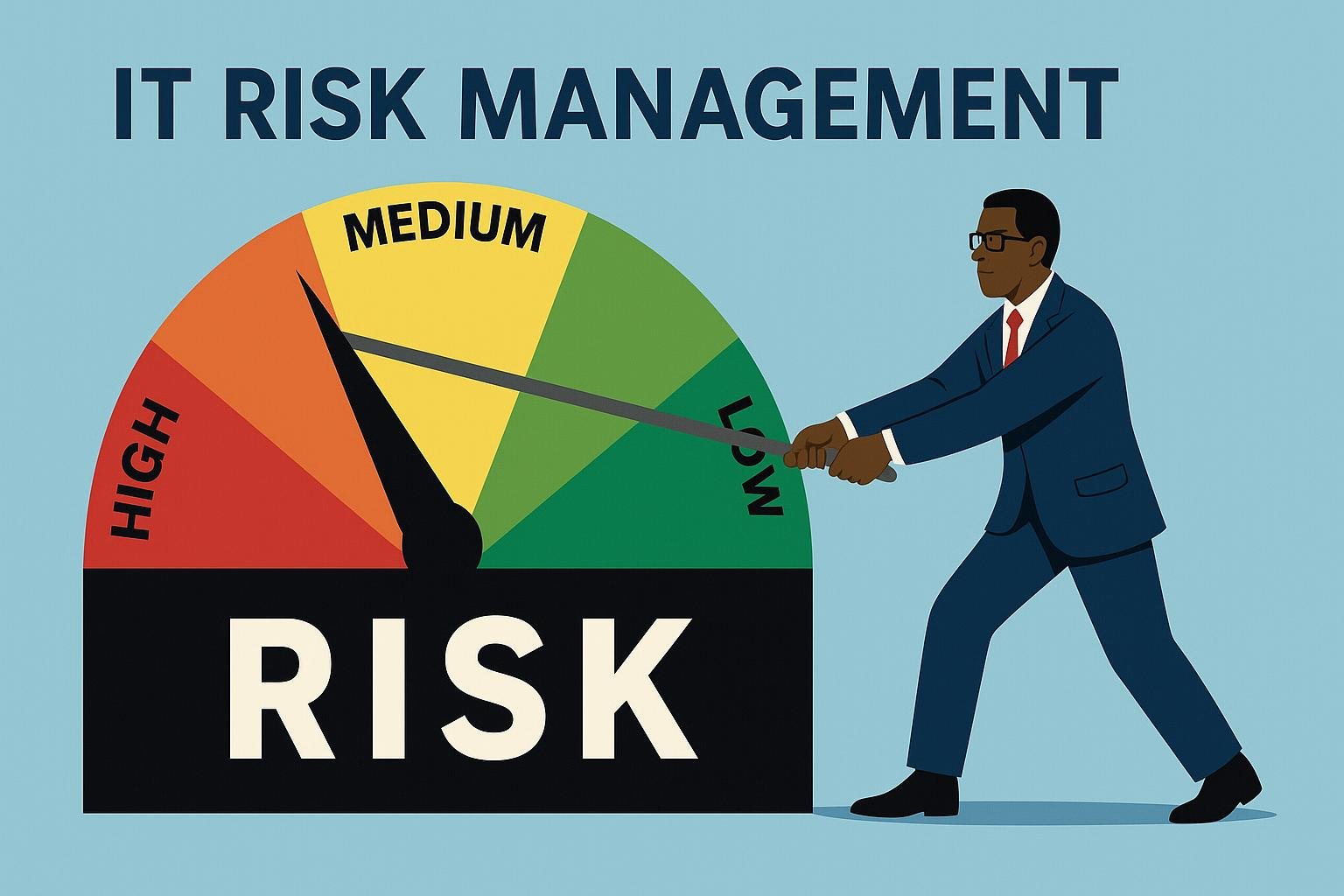Key Considerations for Business Leaders
Picking the right managed IT services partner can shape how your organization handles risk. Your managed IT partner should go beyond just daily operations—they should offer proactive guidance on risk management strategies to keep your data, systems, and operations safe.
If your provider isn’t discussing possible risks or ways to address them, you might miss essential protections. A knowledgeable IT services partner helps you spot vulnerabilities, recommends realistic solutions, and keeps you ahead of new threats.
They should regularly assess and explain risks, ensuring your team knows what’s urgent and how to respond. This kind of insight gives you peace of mind and helps keep your business running smoothly.
Key Takeaways
- Your IT partner should offer ongoing risk management advice.
- Strong collaboration is essential for effective IT risk mitigation.
- If your IT partner isn’t actively addressing risk, it’s worth reassessing their fit.
Understanding Managed IT Services and Risk Management
Managed IT services are essential in keeping your technology reliable, secure, and productive. Good risk management in this partnership helps your business stay resilient against cyber threats, disruptions, and compliance problems.
Definition of Managed IT Services
Managed IT services mean outsourcing IT operations to a third-party partner, often a managed service provider (MSP). These services cover network monitoring, cybersecurity, help desk support, cloud management, data backup, and more.
MSPs sign on to proactively manage and maintain your IT environment. By working with an MSP, you tap into specialized skills and tools you might not have in-house. Your provider brings proven methods and updated technologies to keep your systems running and fix issues fast.
This partnership is usually cost-effective and can scale as your business grows. To dig deeper, check out how organizations outsource IT operations to managed services partners.
The Importance of Risk Management in IT
Risk management in IT means spotting, evaluating, and dealing with threats that could disrupt your business, compromise data, or hurt your reputation. Since cyber threats keep changing, you need a structured risk management process to limit losses and stay compliant.
Your MSP can help you find weak spots, put strong security controls in place, and build response plans for incidents like data breaches or ransomware. Keeping communication open with your provider helps align risk management with your business priorities.
Regular assessments and updates are a must. That way, you always tackle current threats and stay on top of regulatory demands. For more information, see a modern risk management guide.
Common IT Risks Facing Organizations
Organizations deal with a bunch of IT risks that need constant attention. The most common ones include:
- Cybersecurity threats like phishing, malware, and ransomware
- System outages from technical failures or disasters
- Data breaches that cause information leaks or compliance headaches
- Outdated hardware and software that open up vulnerabilities
- Third-party risks from vendors or weak spots in your supply chain
Your MSP should run ongoing risk assessments and vulnerability checks. Their know-how should help you catch incidents early and respond fast to new threats. Staying current on these risks keeps your IT environment safer and helps you avoid major disruptions. For more details, check out this detailed overview on risk management in managed IT services.
Evaluating Your Managed IT Services Partner’s Role in Risk Management
A trustworthy managed IT services partner looks beyond technical fixes. They help you spot, manage, and reduce risks affecting your operations. Key areas to watch are their approach to consultation, their ability to anticipate risks, and whether they adapt solutions to your needs.
Assessing Consultation and Risk Advisory Capabilities
Your IT partner should offer structured advice based on experience and a real grasp of your industry. Check if they conduct regular risk assessments, clearly explain exposures, and give you practical recommendations.
Look for thorough risk reporting, not just quick audits. You want clear documentation of policies, new threats, and compliance gaps. Good partners reference trusted frameworks or regulations that matter to you and help you plan for new risks.
The best providers encourage honest conversations, answer tough questions, and back up your decisions with current expertise. Double-check if the ongoing risk advisory comes with your service agreement or if it’s an extra. For more on due diligence, see this IT due diligence checklist for managed service providers.
Proactive Versus Reactive Risk Strategies
Proactive partners help you avoid downtime, data loss, and expensive surprises. See if your provider regularly monitors systems, hunts for vulnerabilities, and puts preventive controls in place before problems hit.
Ask for proof of patch schedules, threat intelligence updates, and penetration testing. Proactive partners hold strategy sessions, update contingency plans, and train your staff to spot and handle threats.
Conversely, reactive providers only jump in after something goes wrong, which can mean more risk or longer recovery. Consider whether your provider covers business continuity planning, regular backups, and incident response protocols. A partner who cares about resilience will always push for prevention and preparation.
Customization of Risk Management Solutions
Your risk profile isn’t like anyone else’s. The best IT partners customize their risk management services based on your size, compliance needs, business model, and the threats unique to your field.
Ask how your provider tailors their approach. Do they map solutions to your regulatory and operational requirements or just use the same template for everyone?
Check if their monitoring tools and service options can change as your needs shift. For more help, see these 10 key considerations when evaluating managed service providers to ensure your risk management goals match your partner’s delivery.
Key Risk Management Services to Expect from Your IT Partner
A solid managed IT services partner should help you secure sensitive data, keep up with compliance, and prepare for cyber threats. These services are the backbone of good risk management today.
Cybersecurity Policy Development
Your IT partner should work with you to build, roll out, and update cybersecurity policies that fit your organization. Good policies set clear rules for data access, acceptable use, passwords, and how to handle incidents.
The best approach? Collaborate with key business people so the policies work for your goals and daily operations. Keeping these rules up to date helps you adapt to tech changes and new threats.
Multi-factor authentication, access logs, and regular employee training should be part of the mix. Setting these standards reduces human mistakes and gives you a plan for dealing with security incidents.
Regulatory Compliance Guidance
Most businesses have to meet a range of legal, regulatory, and industry standards. Your managed service provider should help you determine which ones apply—HIPAA, GDPR, CMMC, PCI-DSS, etc.
They should offer regular compliance checks, help with documentation, and provide actionable checklists. Your IT partner can also set up technology solutions, like data encryption and secure storage, to help you stay compliant.
Staying compliant lowers your risk for fines, bad press, and legal trouble. A knowledgeable partner explains audit requirements and helps you respond to new regulations, so you’re not left scrambling when rules change.
Threat Detection and Response Planning
Your IT provider should offer proactive threat monitoring, fast incident response, and ongoing system checks. The best partners use security tools to watch your network for anything suspicious, day and night.
If they spot a threat, they should send real-time alerts, detailed reports, and step-by-step plans to fix the issue. Response planning also means running tabletop exercises and practice incidents so your team’s ready for the real thing.
Regular vulnerability scans, security patching, and fast escalation protocols help catch and stop attacks quickly.

Collaboration and Communication in Risk Mitigation
Open communication and teamwork are considerable factors in effective risk mitigation. These approaches help everyone respond to threats together and make better decisions.
Ongoing Risk Assessments and Reporting
Regular risk assessments let you spot new threats as they pop up. When your managed IT services partner schedules these reviews and sends up-to-date reports, you get a clear view of any weak spots that need fixing.
Use easy-to-read reports, executive summaries, and visual dashboards to keep your team informed. Automated alerts and real-time monitoring systems are must-haves for knowing what’s happening.
A feedback loop helps you learn from close calls and minor incidents, not just big ones. This way, you can adjust controls and policies as threats change. Consistent reporting builds trust and lays the groundwork for working together, as AuditBoard points out.
Stakeholder Engagement Processes
Bringing in stakeholders—from IT staff to executives—makes risk strategies more practical. Open channels like workshops, briefings, and online workspaces invite everyone to spot vulnerabilities and suggest fixes.
Clear escalation paths help you address problems quickly. Try using surveys or risk workshops to get feedback from all levels. When people participate, they’re more likely to support and follow risk protocols.
Keeping communication open and regular reduces confusion and ensures everyone knows their role. Collaborative efforts help build a sense of ownership and accountability, making your risk management stronger.
Measuring the Effectiveness of IT Risk Management Advisement
If you want to know how strong your IT risk management is, you need clear ways to measure it. Metrics and regular improvement help ensure your managed IT services partner is helping you.
Performance Metrics and KPIs
Use key performance indicators (KPIs) to measure your risk management. Possible metrics include incident response time, unresolved vulnerabilities, compliance audit rates, and user awareness scores.
Here’s a quick table to help you track KPIs:
| KPI | Description | Target |
|---|---|---|
| Mean Time to Detect (MTTD) | Average time to identify threats | <1 hour |
| Mean Time to Respond (MTTR) | Average time to respond to incidents | <24 hours |
| Remediation Completion Rate | % of vulnerabilities resolved on schedule | >95% |
| Compliance Audit Pass Rate | % of controls met during audit | 100% |
Make it a habit to review these metrics and share results with your team. Many risk management platforms can automate this tracking and reporting for you.
Continuous Improvement Practices
Risk management advice can’t just sit still. You need processes that capture lessons learned, review outcomes, and help you adapt policies.
This means digging into root cause analyses after incidents and building in feedback loops. It’s not always glamorous, but it pays off.
Set up regular reviews with your IT partner. Go over recent risk events and keep your risk register updated.
Encourage folks to share what’s working, what’s not, and talk about new threats. Sometimes, those knowledge-sharing sessions spark real improvements.
Try frameworks that push adaptive risk management—think ongoing vulnerability assessments and tabletop exercises. Using risk management frameworks helps your team stay alert to whatever’s coming next.
Document changes and keep an eye on how they affect your key KPIs. You’ll thank yourself later.
Selecting the Right Managed IT Services Partner for Risk Management
Choosing a managed IT services partner shapes how you handle cybersecurity threats and compliance. If you put risk management expertise and solid communication first, you’re setting your organization up for long-term stability—at least, that’s the plan.
Essential Criteria for Evaluation
Look for partners with a strong record in risk assessment and proactive support. The right managed service provider should bring up-to-date security practices and know your industry’s compliance needs inside and out.
Check how they handle incident response, data backup, and disaster recovery. Don’t just take their word for it—dig in.
Key criteria to look at:
- Third-party certifications, like ISO 27001 or SOC 2
- Clear documentation and policies for security and incident management
- A solid track record with organizations similar to yours
Ensure their tools and monitoring can spot threats early and keep downtime low. Providers who communicate clearly and send regular reports tend to earn trust, and they’re easier to hold accountable. To dive deeper, check out these critical factors in choosing a managed services partner.
Questions to Ask Potential Partners
Asking direct questions helps see if a partner’s ready to manage your risk. Find out how they handle risk evaluations and what safeguards they use to protect your data.
Start with these:
- How do you monitor for security threats around the clock?
- What’s your process for responding to and reporting incidents?
- Can you share examples of cases where you’ve managed compliance or regulatory risks for similar clients?
- Do you run regular vulnerability assessments and actually share the results with clients?
Push for specific answers, and don’t be shy about asking for case studies or references. Check the recommended questions for managed IT service providers for a bigger list.
Future Trends in IT Risk Management
Risk management keeps changing as new technologies roll out and threats evolve. You’ll probably notice ransomware and phishing attacks—especially those sneaky deepfake ones—growing more complex and common.
So, adaptive defenses really aren’t optional anymore.
Artificial intelligence and automation are stepping up to help you spot threats faster and jump on incidents before they spiral. Managed services now use these tools to protect your IT infrastructure and sharpen risk strategies, as mentioned in this piece about mitigating risks with managed services.
Key future trends to watch out for:
- Predictive risk assessment fueled by real-time data analytics
- Rising regulatory demands for data protection
- Automated compliance monitoring
- Cloud security enhancements
- More risk management platforms that fit right in with your current systems
Technology now lets you spot risks faster and with more accuracy. That means you can get ahead of problems instead of always playing catch-up.
Keeping up with these shifts helps your organization stay prepared for whatever’s next. Managed IT services partners can really make a difference here. If you want a broader perspective, you might like this overview of emerging trends in IT risk management.








